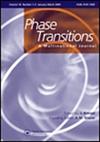Ti掺杂和退火温度对氧化钨(WO3)结构和光磁性能的影响
IF 1.3
4区 材料科学
Q3 CRYSTALLOGRAPHY
引用次数: 0
摘要
摘要采用固相反应法制备了纯WO3和掺钛WO3纳米体系,并在不同温度下退火,研究了其结构、光学和磁学性能的变化。采用X射线衍射、拉曼光谱、紫外-可见光谱、光致发光光谱、振动样品磁强计(VSM)技术进行结构、光学和磁性表征,研究样品中电子结构和无序的修饰。随着掺杂剂离子含量的增加,Ti离子的加入导致单斜单相体系的结晶度下降,而退火温度的升高则增强了结晶度。光学带隙中的红移指示缺陷状态的产生。随着退火温度的升高,由氧空位引起的可见光致发光(PL)发射量减少。磁性实验表明,所制备的样品的铁磁性能随着Ti掺杂和退火温度的升高而降低。本文章由计算机程序翻译,如有差异,请以英文原文为准。
Impact of Ti doping and annealing temperature on structural and opto-magnetic properties of tungsten oxide (WO3)
ABSTRACT Pure and Ti-doped WO3 nano systems synthesized by the solid state reaction method and annealed at different temperatures, were studied for changes in structural, optical and magnetic properties. X-ray diffraction, Raman, UV–Vis, photoluminescence spectroscopy, vibrating sample magnetometer (VSM) techniques were employed for structural, optical and magnetic characterization to study the modification of the electronic structure and disorder developed in the samples. Inclusion of Ti ions leads to degradation in the crystallinity of the monoclinic single phase system with an increase in the content of the dopant ions, whereas increased annealing temperature enhances crystallinity. A red shift in the optical band gap indicates the production of defect states. As the annealing temperature is raised, the amount of visible photoluminescence (PL) emissions caused by oxygen vacancies decreases. Magnetic experiments demonstrate the ferromagnetic properties of the prepared samples, which exhibit a decrease with Ti doping and an increase in annealing temperature.
求助全文
通过发布文献求助,成功后即可免费获取论文全文。
去求助
来源期刊

Phase Transitions
物理-晶体学
CiteScore
3.00
自引率
6.20%
发文量
61
审稿时长
1.4 months
期刊介绍:
Phase Transitions is the only journal devoted exclusively to this important subject. It provides a focus for papers on most aspects of phase transitions in condensed matter. Although emphasis is placed primarily on experimental work, theoretical papers are welcome if they have some bearing on experimental results. The areas of interest include:
-structural phase transitions (ferroelectric, ferroelastic, multiferroic, order-disorder, Jahn-Teller, etc.) under a range of external parameters (temperature, pressure, strain, electric/magnetic fields, etc.)
-geophysical phase transitions
-metal-insulator phase transitions
-superconducting and superfluid transitions
-magnetic phase transitions
-critical phenomena and physical properties at phase transitions
-liquid crystals
-technological applications of phase transitions
-quantum phase transitions
Phase Transitions publishes both research papers and invited articles devoted to special topics. Major review papers are particularly welcome. A further emphasis of the journal is the publication of a selected number of small workshops, which are at the forefront of their field.
 求助内容:
求助内容: 应助结果提醒方式:
应助结果提醒方式:


